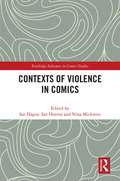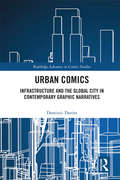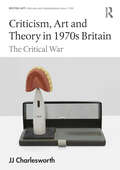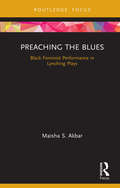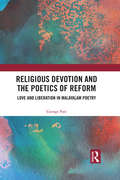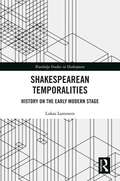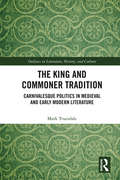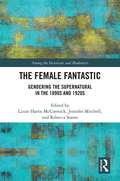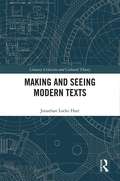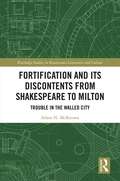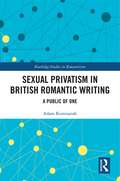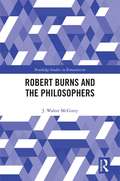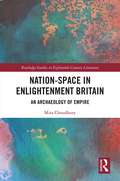- Table View
- List View
Contexts of Violence in Comics (Routledge Advances in Comics Studies)
by Ian Hague Ian Gordon Nina MickwitzThis book is part of a nuanced two-volume examination of the ways in which violence in comics is presented in different texts, genres, cultures and contexts. Contexts of Violence in Comics asks the reader to consider the ways in which violence and its representations may be enabled or restricted by the contexts in which they take place. It analyzes how structures and organising principles, be they cultural, historical, legal, political or spatial, might encourage, demand or prevent violence. It deals with the issue of scale: violence in the context of war versus violence in the context of an individual murder, and provides insights into the context of war and peace, ethnic and identity-based violence, as well as examining issues of justice and memory. This will be a key text and essential reference for scholars and students at all levels in Comics Studies, and Cultural and Media Studies more generally.
Urban Comics: Infrastructure and the Global City in Contemporary Graphic Narratives (Routledge Advances in Comics Studies)
by Dominic DaviesUrban Comics: Infrastructure and the Global City in Contemporary Graphic Narratives makes an important and timely contribution both to comics studies and urban studies, offering a decolonisation and reconfiguration of both of these already interdisciplinary fields. With chapter-length discussions of comics from cities such as Cairo, Cape Town, New Orleans, Delhi and Beirut, this book shows how artistic collectives and urban social movements working across the global South are producing some of the most exciting and formally innovative graphic narratives of the contemporary moment.Throughout, the author reads an expansive range of graphic narratives through the vocabulary of urban studies to argue that these formal innovations should be thought of as a kind of infrastructure. This ‘infrastructural form’ allows urban comics to reveal that the built environments of our cities are not static, banal, or depoliticised, but rather highly charged material spaces that allow some forms of social life to exist while also prohibiting others. Built from a formal infrastructure of grids, gutters and panels, and capable of volumetric, multi-scalar perspectives, this book shows how urban comics are able to represent, repair and even rebuild contemporary global cities toward more socially just and sustainable ends.Operating at the intersection of comics studies and urban studies, and offering large global surveys alongside close textual and visual analyses, this book explores and opens up the fascinating relationship between comics and graphic narratives, on the one hand, and cities and urban spaces, on the other.
Urban Comics: Infrastructure and the Global City in Contemporary Graphic Narratives (Routledge Advances in Comics Studies)
by Dominic DaviesUrban Comics: Infrastructure and the Global City in Contemporary Graphic Narratives makes an important and timely contribution both to comics studies and urban studies, offering a decolonisation and reconfiguration of both of these already interdisciplinary fields. With chapter-length discussions of comics from cities such as Cairo, Cape Town, New Orleans, Delhi and Beirut, this book shows how artistic collectives and urban social movements working across the global South are producing some of the most exciting and formally innovative graphic narratives of the contemporary moment.Throughout, the author reads an expansive range of graphic narratives through the vocabulary of urban studies to argue that these formal innovations should be thought of as a kind of infrastructure. This ‘infrastructural form’ allows urban comics to reveal that the built environments of our cities are not static, banal, or depoliticised, but rather highly charged material spaces that allow some forms of social life to exist while also prohibiting others. Built from a formal infrastructure of grids, gutters and panels, and capable of volumetric, multi-scalar perspectives, this book shows how urban comics are able to represent, repair and even rebuild contemporary global cities toward more socially just and sustainable ends.Operating at the intersection of comics studies and urban studies, and offering large global surveys alongside close textual and visual analyses, this book explores and opens up the fascinating relationship between comics and graphic narratives, on the one hand, and cities and urban spaces, on the other.
Criticism, Art and Theory in 1970s Britain: The Critical War (ISSN)
by JJ CharlesworthA critical study of the life of art criticism in the 1970s, this volume traces the evolution of art and art criticism in a pivotal period in post-war British history.JJ Charlesworth explores how art critics and the art press attempted to negotiate new developments in art, faced with the challenges of conceptualism, alternative media, new social movements and radical innovations in philosophy and theory. This is the first comprehensive study of the art press and art criticism in Britain during this pivotal period, seen through the lens of its art press, charting the arguments and ideas that would come to shape contemporary art as we know it today.This book will be of interest to scholars working in art history, British cultural history and history of journalism.
Criticism, Art and Theory in 1970s Britain: The Critical War (ISSN)
by JJ CharlesworthA critical study of the life of art criticism in the 1970s, this volume traces the evolution of art and art criticism in a pivotal period in post-war British history.JJ Charlesworth explores how art critics and the art press attempted to negotiate new developments in art, faced with the challenges of conceptualism, alternative media, new social movements and radical innovations in philosophy and theory. This is the first comprehensive study of the art press and art criticism in Britain during this pivotal period, seen through the lens of its art press, charting the arguments and ideas that would come to shape contemporary art as we know it today.This book will be of interest to scholars working in art history, British cultural history and history of journalism.
Preaching the Blues: Black Feminist Performance in Lynching Plays (Routledge Advances in Theatre & Performance Studies)
by Maisha S. AkbarPreaching the Blues: Black Feminist Performance in Lynching Plays examines several lynching plays to foreground black women’s performances as non-normative subjects who challenge white supremacist ideology. Maisha S. Akbar re-maps the study of lynching drama by examining plays that are contingent upon race-based settings in black households versus white households. She also discusses performances of lynching plays at Historically Black Colleges and Universities (HBCUs) in the South and reviews lynching plays closely tied to black school campuses. By focusing on current examples and impacts of lynching plays in the public sphere, this book grounds this historical form of theatre in the present day with depth and relevance. Of interest to scholars and students of both general Theatre and Performance Studies, and of African American Theatre and Drama, Preaching the Blues foregrounds the importance of black feminist artists in lynching culture and interdisciplinary scholarship.
Preaching the Blues: Black Feminist Performance in Lynching Plays (Routledge Advances in Theatre & Performance Studies)
by Maisha S. AkbarPreaching the Blues: Black Feminist Performance in Lynching Plays examines several lynching plays to foreground black women’s performances as non-normative subjects who challenge white supremacist ideology. Maisha S. Akbar re-maps the study of lynching drama by examining plays that are contingent upon race-based settings in black households versus white households. She also discusses performances of lynching plays at Historically Black Colleges and Universities (HBCUs) in the South and reviews lynching plays closely tied to black school campuses. By focusing on current examples and impacts of lynching plays in the public sphere, this book grounds this historical form of theatre in the present day with depth and relevance. Of interest to scholars and students of both general Theatre and Performance Studies, and of African American Theatre and Drama, Preaching the Blues foregrounds the importance of black feminist artists in lynching culture and interdisciplinary scholarship.
Religious Devotion and the Poetics of Reform: Love and Liberation in Malayalam Poetry
by George PatiThe poetry emanating from the bhakti tradition of devotional love in India has been both a religious expression and a form of resistance to hierarchies of caste, gender, and colonialism. Some scholars have read this art form through the lens of resistance and reform, but others have responded that imposing an interpretive framework on these poems fails to appreciate their authentic expressions of devotion. This book argues that these declarations of love and piety can simultaneously represent efforts towards emancipation at the spiritual, political, and social level. This book, through a close study of Naḷini (1911), a Malayalam lyric poem, as well as other poems, authored by Mahākavi Kumāran Āśān (1873–1924), a low-caste Kerala poet, demonstrates how Āśān employed a theme of love among humans during the modern period in Kerala that was grounded in the native South Indian bhakti understanding of love of the deity. Āśān believed that personal religious freedom comes from devotion to the deity, and that love for humans must emanate from love of the deity. In showing how devotional religious expression also served as a resistance movement, this study provides new perspective on an understudied area of the colonial period. Bringing to light an under-explored medium, in both religious and artistic terms, this book will be of great interest to scholars of religious studies, Hindu studies, and religion and literature, as well as academics with an interest in Indian culture.
Religious Devotion and the Poetics of Reform: Love and Liberation in Malayalam Poetry
by George PatiThe poetry emanating from the bhakti tradition of devotional love in India has been both a religious expression and a form of resistance to hierarchies of caste, gender, and colonialism. Some scholars have read this art form through the lens of resistance and reform, but others have responded that imposing an interpretive framework on these poems fails to appreciate their authentic expressions of devotion. This book argues that these declarations of love and piety can simultaneously represent efforts towards emancipation at the spiritual, political, and social level. This book, through a close study of Naḷini (1911), a Malayalam lyric poem, as well as other poems, authored by Mahākavi Kumāran Āśān (1873–1924), a low-caste Kerala poet, demonstrates how Āśān employed a theme of love among humans during the modern period in Kerala that was grounded in the native South Indian bhakti understanding of love of the deity. Āśān believed that personal religious freedom comes from devotion to the deity, and that love for humans must emanate from love of the deity. In showing how devotional religious expression also served as a resistance movement, this study provides new perspective on an understudied area of the colonial period. Bringing to light an under-explored medium, in both religious and artistic terms, this book will be of great interest to scholars of religious studies, Hindu studies, and religion and literature, as well as academics with an interest in Indian culture.
Shakespearean Temporalities: History on the Early Modern Stage (Routledge Studies in Shakespeare)
by Lukas LammersShakespearean Temporalities addresses a critical neglect in Early Modern Performance and Shakespeare Studies, revising widely prevailing and long-standing assumptions about the performance and reception of history on the early modern stage. Demonstrating that theatre, at the turn of the seventeenth century, thrived on an intense fascination with perceived tensions between (medieval) past and (early modern) present, this volume uncovers a dimension of historical drama that has been largely neglected due to a strong focus on nationhood and a predilection for ‘topical’ readings. It moreover reassesses genre conventions by venturing beyond the threshold of the supposed "death of the history play," in 1603. Closely analysing a broad range of Shakespeare’s historical drama, it explores the dramatic techniques that allow the theatre to perform historical distance. An experience of historical contingency through an immersion in a world ontologically related yet temporally removed is thus revealed as a major appeal of historical drama and a striking aspect of Shakespeare’s history plays. With a focus on performance, the experience of playgoers, and the dynamics that resulted from the collective production of dramatic historiography by competing companies, the book offers the first analysis of what can be referred to as Shakespeare’s dramaturgy of historical temporality.
Shakespearean Temporalities: History on the Early Modern Stage (Routledge Studies in Shakespeare)
by Lukas LammersShakespearean Temporalities addresses a critical neglect in Early Modern Performance and Shakespeare Studies, revising widely prevailing and long-standing assumptions about the performance and reception of history on the early modern stage. Demonstrating that theatre, at the turn of the seventeenth century, thrived on an intense fascination with perceived tensions between (medieval) past and (early modern) present, this volume uncovers a dimension of historical drama that has been largely neglected due to a strong focus on nationhood and a predilection for ‘topical’ readings. It moreover reassesses genre conventions by venturing beyond the threshold of the supposed "death of the history play," in 1603. Closely analysing a broad range of Shakespeare’s historical drama, it explores the dramatic techniques that allow the theatre to perform historical distance. An experience of historical contingency through an immersion in a world ontologically related yet temporally removed is thus revealed as a major appeal of historical drama and a striking aspect of Shakespeare’s history plays. With a focus on performance, the experience of playgoers, and the dynamics that resulted from the collective production of dramatic historiography by competing companies, the book offers the first analysis of what can be referred to as Shakespeare’s dramaturgy of historical temporality.
The King and Commoner Tradition: Carnivalesque Politics in Medieval and Early Modern Literature (Outlaws in Literature, History, and Culture #4)
by Mark TruesdaleKing and Commoner tales were hugely popular across the late medieval and early modern periods, their cultural influence extending from Robin Hood ballads to Shakespearean national histories. This study represents the first detailed exploration of this rich and fascinating literary tradition, tracing its development across deeply politicized fifteenth-century comic tales and early modern ballads. The medieval King and Commoner tales depict an incognito king becoming lost in the forest and encountering a disgruntled commoner who complains of class oppression and poaches the king’s deer. This is an upside-down world of tricksters, violence, and politicized feasting that critiques and deconstructs medieval hierarchy. The commoners of these tales utilize the inversion of the medieval carnival, crowning themselves as liminal mock kings in the forest while threatening to rend and devour a body politic that would oppress them. These tales are complex and ambiguous, reimagining the socio-political upheaval of the late medieval period in sophisticated ruminations on class relations. By contrast, the early modern ballads and chapbooks see the tradition undergo a conservative metamorphosis. Suppressing its more radical elements amid a celebration of proto-panoptical kings, the tradition remerges as royalist propaganda in which the king watches his thankful subjects through the keyhole.
The King and Commoner Tradition: Carnivalesque Politics in Medieval and Early Modern Literature (Outlaws in Literature, History, and Culture)
by Mark TruesdaleKing and Commoner tales were hugely popular across the late medieval and early modern periods, their cultural influence extending from Robin Hood ballads to Shakespearean national histories. This study represents the first detailed exploration of this rich and fascinating literary tradition, tracing its development across deeply politicized fifteenth-century comic tales and early modern ballads. The medieval King and Commoner tales depict an incognito king becoming lost in the forest and encountering a disgruntled commoner who complains of class oppression and poaches the king’s deer. This is an upside-down world of tricksters, violence, and politicized feasting that critiques and deconstructs medieval hierarchy. The commoners of these tales utilize the inversion of the medieval carnival, crowning themselves as liminal mock kings in the forest while threatening to rend and devour a body politic that would oppress them. These tales are complex and ambiguous, reimagining the socio-political upheaval of the late medieval period in sophisticated ruminations on class relations. By contrast, the early modern ballads and chapbooks see the tradition undergo a conservative metamorphosis. Suppressing its more radical elements amid a celebration of proto-panoptical kings, the tradition remerges as royalist propaganda in which the king watches his thankful subjects through the keyhole.
The Female Fantastic: Gendering the Supernatural in the 1890s and 1920s (Among the Victorians and Modernists)
by Lizzie Harris McCormick Jennifer Mitchell Rebecca SoaresFor women-identified writers of both eras, the fantastic offered double vision. Not only did the genre offer strategic cover for challenging the status quo, but also a heuristic mechanism for teasing out the gendered psyche’s links to creative, personal, and erotic agency. These dynamic presentations of female and gender-queer subjectivity, are linked in intriguing and complex matrices to key moments in gender(ed) history. This volume contains essays from international scholars covering a wide range of topics, including werewolves, mummies, fairies, demons, time travel, ghosts, haunted spaces and objects, race, gender, queerness, monstrosity, madness, incest, empire, medicine, and science. By interrogating two non-consecutive decades, we seek to uncover the inter-relationships among fantastic literature, feminism, and modern identity and culture. Indeed, while this book considers the relationship between the 1890s and 1920s, it is more an examination of women’s modernism in light of gendered literary production during the fin-de-siècle than the reverse.
The Female Fantastic: Gendering the Supernatural in the 1890s and 1920s (Among the Victorians and Modernists)
by Lizzie Harris McCormick Jennifer Mitchell Rebecca SoaresFor women-identified writers of both eras, the fantastic offered double vision. Not only did the genre offer strategic cover for challenging the status quo, but also a heuristic mechanism for teasing out the gendered psyche’s links to creative, personal, and erotic agency. These dynamic presentations of female and gender-queer subjectivity, are linked in intriguing and complex matrices to key moments in gender(ed) history. This volume contains essays from international scholars covering a wide range of topics, including werewolves, mummies, fairies, demons, time travel, ghosts, haunted spaces and objects, race, gender, queerness, monstrosity, madness, incest, empire, medicine, and science. By interrogating two non-consecutive decades, we seek to uncover the inter-relationships among fantastic literature, feminism, and modern identity and culture. Indeed, while this book considers the relationship between the 1890s and 1920s, it is more an examination of women’s modernism in light of gendered literary production during the fin-de-siècle than the reverse.
Making and Seeing Modern Texts (Literary Criticism and Cultural Theory)
by Jonathan Locke HartMaking and Seeing Modern Texts explores the poetics of texts through a close reading and analysis across the genres of poetry, drama, fiction, non-fiction travel literature and theory. This volume demonstrates that prose, as much as poetry, share the making and seeing of language, literary practice, and theory. Genre, then, is presented as a guide that crosses multiple boundaries. This volume selects different ways to examine texts, discussing Michael Ondaatje’s early poetry and examining narrative in Philip Roth’s The Human Stain. The book examines images in poetry, narrative in fiction, prefaces in non-fiction, metatheatre in drama, and attempts to see the modern and postmodern in theory, all of which show us the complexities of modernity or later modernity. One of the innovations is that the author, a literary critic/theorist, poet and historian, takes his training in practice and theory and shows, through examples of each, how language operates across genres.
Making and Seeing Modern Texts (Literary Criticism and Cultural Theory)
by Jonathan Locke HartMaking and Seeing Modern Texts explores the poetics of texts through a close reading and analysis across the genres of poetry, drama, fiction, non-fiction travel literature and theory. This volume demonstrates that prose, as much as poetry, share the making and seeing of language, literary practice, and theory. Genre, then, is presented as a guide that crosses multiple boundaries. This volume selects different ways to examine texts, discussing Michael Ondaatje’s early poetry and examining narrative in Philip Roth’s The Human Stain. The book examines images in poetry, narrative in fiction, prefaces in non-fiction, metatheatre in drama, and attempts to see the modern and postmodern in theory, all of which show us the complexities of modernity or later modernity. One of the innovations is that the author, a literary critic/theorist, poet and historian, takes his training in practice and theory and shows, through examples of each, how language operates across genres.
Fortification and Its Discontents from Shakespeare to Milton: Trouble in the Walled City (Routledge Studies in Renaissance Literature and Culture)
by Adam N. McKeownFortification and Its Discontents from Shakespeare to Milton gives new coherence to the literature of the early modern Atlantic world by placing it in the context of radical changes to urban space following the Italian War of 1494-1498. The new walled city that emerged in the sixteenth and seventeenth centuries on both sides of the Atlantic provided an outlet for a wide range of humanistic fascinations with urban design, composition, and community organization, but it also promoted centrality of control and subordinated the human environment to military functionality. Examining William Shakespeare, Edmund Spenser, John Winthrop, and John Milton, this volume shows how the literature of England and New England explores and challenges the new walled city as England struggled to define the sprawling metropolis of London, translate English urban spaces into Ireland and North America, and, later, survive a long civil war.
Fortification and Its Discontents from Shakespeare to Milton: Trouble in the Walled City (Routledge Studies in Renaissance Literature and Culture)
by Adam N. McKeownFortification and Its Discontents from Shakespeare to Milton gives new coherence to the literature of the early modern Atlantic world by placing it in the context of radical changes to urban space following the Italian War of 1494-1498. The new walled city that emerged in the sixteenth and seventeenth centuries on both sides of the Atlantic provided an outlet for a wide range of humanistic fascinations with urban design, composition, and community organization, but it also promoted centrality of control and subordinated the human environment to military functionality. Examining William Shakespeare, Edmund Spenser, John Winthrop, and John Milton, this volume shows how the literature of England and New England explores and challenges the new walled city as England struggled to define the sprawling metropolis of London, translate English urban spaces into Ireland and North America, and, later, survive a long civil war.
Sexual Privatism in British Romantic Writing: A Public of One (Routledge Studies in Romanticism)
by Adam KomisarukThe Romantic age, though often associated with free erotic expression, was ambivalent about what if anything sex had to do with the public sphere. Late-eighteenth- and early-nineteenth-century British texts often repressed the very sexual energies they claimed to be bringing into the open. The delineation of what could and could not be said and done in the name of physical pleasure was of a piece with the capitalist consecration of the social trust to the individual profit-motive. Both these practices, moreover, presupposed a determinate self with sovereignty over its own interests. Writings from and about some nominally public institutions were thus characterized by privatism—a sexual, economic and ontological withdrawal from otherness. Sexual Privatism in British Romantic Writing: A Public of One explores how this threefold ideology was both propagated and resisted, wittingly and unwittingly, successfully and unsuccessfully, in such Romantic "publics" as rape-law, sodomy-law, adultery-law, high-profile scandals, the population debates, and club-culture. It includes readings of imaginative literature by William Beckford, William Blake, Erasmus Darwin, Mary Hays, Percy Shelley and Mary Wollstonecraft; works of political economy by Jeremy Bentham, William Cobbett, William Godwin, William Hazlitt and Thomas Robert Malthus; as well as contemporary legal treatises, popular journalism and satirical pamphlets.
Sexual Privatism in British Romantic Writing: A Public of One (Routledge Studies in Romanticism)
by Adam KomisarukThe Romantic age, though often associated with free erotic expression, was ambivalent about what if anything sex had to do with the public sphere. Late-eighteenth- and early-nineteenth-century British texts often repressed the very sexual energies they claimed to be bringing into the open. The delineation of what could and could not be said and done in the name of physical pleasure was of a piece with the capitalist consecration of the social trust to the individual profit-motive. Both these practices, moreover, presupposed a determinate self with sovereignty over its own interests. Writings from and about some nominally public institutions were thus characterized by privatism—a sexual, economic and ontological withdrawal from otherness. Sexual Privatism in British Romantic Writing: A Public of One explores how this threefold ideology was both propagated and resisted, wittingly and unwittingly, successfully and unsuccessfully, in such Romantic "publics" as rape-law, sodomy-law, adultery-law, high-profile scandals, the population debates, and club-culture. It includes readings of imaginative literature by William Beckford, William Blake, Erasmus Darwin, Mary Hays, Percy Shelley and Mary Wollstonecraft; works of political economy by Jeremy Bentham, William Cobbett, William Godwin, William Hazlitt and Thomas Robert Malthus; as well as contemporary legal treatises, popular journalism and satirical pamphlets.
Robert Burns and the Philosophers (Routledge Studies in Romanticism)
by J Walter McGintyThis volume expounds the influence of Robert Burns’s reading of Philosophy on his life and work, supplementing this with his personal encounters with those philosophers he met. The work begins with the Homespun Philosophy of his early years under the tutelage of William Burnes and John Murdoch, then examines in detail some of the texts of John Locke, Adam Smith and Francis Hutcheson, including other writers who reflect Hutcheson’s thinking. Further chapters include the exploration on Thomas Reid, Dugald Stewart, Archibald Alison and William Greenfield. Robert Burns and the Philosophers does not purport to be a work of philosophy but rather to show the poet’s reaction to the subject and the development of his understanding. This work opens up a subject that hitherto has been almost unexplored.
Robert Burns and the Philosophers (Routledge Studies in Romanticism)
by J Walter McGintyThis volume expounds the influence of Robert Burns’s reading of Philosophy on his life and work, supplementing this with his personal encounters with those philosophers he met. The work begins with the Homespun Philosophy of his early years under the tutelage of William Burnes and John Murdoch, then examines in detail some of the texts of John Locke, Adam Smith and Francis Hutcheson, including other writers who reflect Hutcheson’s thinking. Further chapters include the exploration on Thomas Reid, Dugald Stewart, Archibald Alison and William Greenfield. Robert Burns and the Philosophers does not purport to be a work of philosophy but rather to show the poet’s reaction to the subject and the development of his understanding. This work opens up a subject that hitherto has been almost unexplored.
Nation-Space in Enlightenment Britain: An Archaeology of Empire (Routledge Studies in Eighteenth-Century Literature)
by Mita ChoudhuryNation-Space in Enlightenment Britain: An Archaeology of Empire is a provocative intervention that extends considerably the parameters of on-going dialogues about British identity during the Enlightenment. Thoughtfully interdisciplinary and with an allegiance to the culture which literary production engenders, this book describes how British identity emerges not despite of but due to its fluid, volatile, and subversive impulses and expressions. The imperial establishment—codified in the logics of the corporation, the academy, the cathedral, the theater, as well the private parlor or garden—derives its power and sustainability from scripting and then championing a solid resistance to precisely those subversive elements which threaten or undermine the foundations of order and liberalism in civil society. Choudhury argues that imperial Britain can best be understood in terms of this culture’s investment in spatial alignments which celebrated a radial interface with remote points of commercial interest. The volume contends Daniel Defoe, Arthur Onslow, David Garrick, Joseph Banks, Daniel Solander, Hans Sloane, Francis Barber, Samuel Johnson, Charles Burney, George Frideric Handel were not merely part of a dazzling line-up of the architects of empire. In retrospect, their contributions and various engagements reflect remarkably modern patterns of the corporatization of culture and this culture’s dependence on, and thus its collusion with, commerce.
Nation-Space in Enlightenment Britain: An Archaeology of Empire (Routledge Studies in Eighteenth-Century Literature)
by Mita ChoudhuryNation-Space in Enlightenment Britain: An Archaeology of Empire is a provocative intervention that extends considerably the parameters of on-going dialogues about British identity during the Enlightenment. Thoughtfully interdisciplinary and with an allegiance to the culture which literary production engenders, this book describes how British identity emerges not despite of but due to its fluid, volatile, and subversive impulses and expressions. The imperial establishment—codified in the logics of the corporation, the academy, the cathedral, the theater, as well the private parlor or garden—derives its power and sustainability from scripting and then championing a solid resistance to precisely those subversive elements which threaten or undermine the foundations of order and liberalism in civil society. Choudhury argues that imperial Britain can best be understood in terms of this culture’s investment in spatial alignments which celebrated a radial interface with remote points of commercial interest. The volume contends Daniel Defoe, Arthur Onslow, David Garrick, Joseph Banks, Daniel Solander, Hans Sloane, Francis Barber, Samuel Johnson, Charles Burney, George Frideric Handel were not merely part of a dazzling line-up of the architects of empire. In retrospect, their contributions and various engagements reflect remarkably modern patterns of the corporatization of culture and this culture’s dependence on, and thus its collusion with, commerce.
